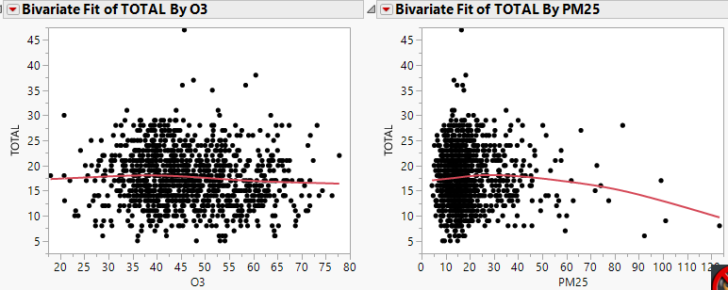No association between air quality (PM2.5, ozone) and hospital admissions for asthma in University of California-Davis Health System during 2010-2012 (19,000+ cases).

Summary
Average ground-level ozone (O3) and fine particulate matter (PM2.5) measurements were not correlated with 19,327 patient admissions for asthma at the University of California-Davis Medical Center (UCDMC) during 2010-2012.
Introduction
The U.S. Environmental Protection Agency (EPA) asserts that exposures to ambient O3 and PM2.5 increase hospital emergency admissions for asthma.
The EPA claims, for example, that reducing the 8-hour ozone standard from the current 75 parts per billion (ppb) to 65 ppb would reduce the number of asthma exacerbations by 38,000 and related hospitalizations by 11,000 annually.
O3 and PM2.5 measurements were compared with hospital admissions for asthma in the UCDMC, a hospital system that serves 33 counties and a population of 6 million in Central and Northern California.
Methods
Through the California Public Records Act, we obtained the daily tally of hospital admissions for asthma and related respiratory diagnoses from the UCDMC for the period January 1, 2010 to December 31, 2012, a total of 19,327 inpatient and emergency admissions.
Daily tallies were correlated with the average daily O3 and PM2.5 levels at the highest air basin monitors as reported by the California Air Resources Board for the Sacramento Valley Air Basin. Correlations were examined on a same day, 1-day lag, 2-day lag and 3-day lag bases.
Results
The Pearson correlations between O3/PM2.5 measurements and hospital admissions are presented in the table below.
A Pearson’s correlation of 1.0 indicates perfect correlation (i.e., higher ozone measurements are correlated with more asthma hospital admissions), a −1.0 indicates perfect inverse correlation (higher ozone measurements are correlated with fewer hospital admissions) and zero indicates no correlation between ozone measurement and hospital admissions.
No correlation presented below indicates that O3 or PM2.5 is associated with asthma admissions.
Asthma admissions at the UCDMC account for about 10 percent of emergency admissions.
| Pollutant | Pearson’s correlation |
| O3 (No lag) | -0.07 |
| O3 (1-day lag) | -0.11 |
| O3 (2-day lag) | -0.13 |
| O3 (3-day lag) | -0.13 |
| PM2.5 (No lag) | -0.02 |
| PM2.5 (1-day lag) | 0.02 |
| PM2.5 (2-day lag) | 0.02 |
| PM2.5 (3-day lag) | 0.03 |
Discussion
These results indicate that O3 and PM2.5 measurements in the Sacramento Valley Air Basin were not correlated with asthma admissions at the UCMDC for the three-year period January 1, 2010 to December 31, 2012.
If ambient O3 and PM2.5 measurements were in fact associated with hospital admissions for asthma, one could reasonably expect — and, in fact — ought to find some correlation in these data. But such a correlation was not identified.
Note: The study data are available upon request.
4/23/15, Scientists discover root cause of asthma, per published study in Science Translational Medicine-Irish Examiner, BBC (It’s not CO2)
4/23/15, “Cardiff University scientists discover asthma’s root cause,” BBC
.
“Scientists at Cardiff University have identified the potential root cause of asthma for the first time, along with a new treatment.
Researchers have proved that a receptor, known as the calcium sensing receptor or CaSR, causes asthma. This has led them to discover that the condition could be treated using existing drugs called calcilytics.”
4/24/15, “Cure for asthma likely in 5 years as root cause found,” Irish Examiner, Evelyn Ring
Sorry, but the local news stations have built ozone reports and maps into their broadcasts, so they will not stop.
You see, anything that costs them extra money or causes difficulty for them will not be allowed.